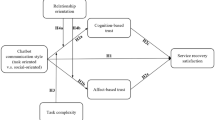Abstract
The Internet has led to an unprecedented diversity in the news delivery sector. Today’s news consumers no longer inform themselves through newspapers alone. Rather it is radio and TV and increasingly also newspaper websites, social media channels, and dedicated news apps, which give them a great choice in how to keep up with ongoing developments. In this context, much hope has recently been placed on so-called news chatbots as a novel delivery format. Yet, little is known about the suitability of these chatbots as a news medium. Hence, the work presented in this paper aimed to trigger respective investigations by focusing on intrinsic motivation to use news chatbots and the resulting user engagement. In an experimental study (n = 60) we compared a linear news delivery mode in the form of a one-way newsflash delivered by a chatbot with a conversational news delivery mode in the form of back-and-forth chatbot interactions. Results show that people feel less pressured and stressed in the conversational mode, while the linear mode had a negative effect on the intrinsic motivation to use the chatbot. Furthermore, we found that the conversational mode had a positive impact on user engagement.
Access this chapter
Tax calculation will be finalised at checkout
Purchases are for personal use only
Similar content being viewed by others
Notes
- 1.
Online: https://www.pewresearch.org/fact-tank/2019/05/16/facts-about-americans-and-facebook/ [accessed: January 30th 2022].
- 2.
Online: https://www.pewresearch.org/fact-tank/2017/06/12/growth-in-mobile- news-use-driven-by-older-adults/ [accessed: January 30th 2022].
- 3.
Online: https://www.pewresearch.org/internet/2010/03/01/understanding-the-participatory-news-consumer/ [accessed: January 30th 2022].
- 4.
Online: https://de.statista.com/statistik/daten/studie/171257/umfrage/normaler-weise-genutzte-quelle-fuer-informationen/ [accessed: January 30th 2022].
- 5.
Online: https://www.pewresearch.org/politics/2002/06/09/publics-news-habits- little-changed-by-september-11/ [accessed: January 30th 2022].
- 6.
Online: https://www.businessinsider.com/the-messaging-app-report-2016-4-23? international=true&r=US&IR=T [accessed: January 30th 2022].
- 7.
Online: https://www.digitalnewsreport.org/survey/2018/the-rise-of-messaging- apps-for-news/ [accessed: January 30th 2022].
- 8.
Online: https://eu.usatoday.com/story/tech/news/2016/03/30/microsof-ceo-nadella-bots-new-apps/82431672/ [accessed: January 30th 2022].
- 9.
Online: https://flowxo.com/ [accessed: January 26th 2022].
- 10.
Online: https://telegram.org/ [accessed: January 26th 2022].
References
Adamopoulou, E., Moussiades, L.: Chatbots: history, technology, and applications. Mach. Learn. Appl. 2, 100006 (2020)
Batra, B.: News communication through Whatsapp. Int. J. Inf. Futuristic Res. 3(10), 3725–3733 (2016)
Bipat, T., Wilson, T., Kurniawan, O., Choi, Y.J.S., Starbird, K.: It is not all fun and games: breaking news consumption on snapchat. In: Proceedings of the 52nd Hawaii International Conference on System Sciences (2019)
Chyi, H.I., Chadha, M.: News on new devices: Is multi-platform news consumption a reality? Journalism Pract. 6(4), 431–449 (2012)
Ford, H., Hutchinson, J.: Newsbots that mediate journalist and audience relationships. Digit. Journalism 7(8), 1013–1031 (2019)
Gentsch, P.: AI in Marketing, Sales and Service: How Marketers Without a Data Science Degree can Use AI, Big Data and Bots. Springer, Cham (2018). https://doi.org/10.1007/978-3-319-89957-2
Hong, H., Oh, H.J.: Utilizing bots for sustainable news business: understanding users’ perspectives of news bots in the age of social media. Sustainability 12(16), 6515 (2020)
Huang, E.: The causes of youths’ low news consumption and strategies for making youths happy news consumers. Convergence 15(1), 105–122 (2009)
Jones, B., Jones, R.: Public service chatbots: automating conversation with BBC news. Digit. Journalism 7(8), 1032–1053 (2019)
Marchionni, D.: Conversational journalism in practice: a case study of the Seattle times’ 2010 Pulitzer prize for breaking news reporting. Digit. Journalism 1(2), 252–269 (2013)
McAuley, E., Duncan, T., Tammen, V.V.: Psychometric properties of the intrinsic motivation inventory in a competitive sport setting: a confirmatory factor analysis. Res. Quart. Exerc. Sport 60(1), 48–58 (1989)
Nelson, J.L., Lei, R.F.: The effect of digital platforms on news audience behavior. Digit. Journalism 6(5), 619–633 (2018)
Pavlik, J.V.: Innovation and the future of journalism. Digit. Journalism 1(2), 181–193 (2013)
Sehl, A., Cornia, A., Nielsen, R.K.: Public service news and digital media. Reuters Institute Reports (2016)
Tong, J., Lo, S.H.: Digital Technology and Journalism. Springer, Cham (2017). https://doi.org/10.1007/978-3-319-55026-8
Van Doorn, M., Duivestein, S.: The bot effect: ‘friending your brand’. Report. Applied Innovation Exchange, SogetiLabs (2016)
Vázquez-Herrero, J., Negreira-Rey, M.C., López-García, X.: Let’s dance the news! how the news media are adapting to the logic of tiktok. Journalism 1464884920969092 (2020)
Yin, J., Goh, T.T., Yang, B., Xiaobin, Y.: Conversation technology with micro-learning: the impact of chatbot-based learning on students’ learning motivation and performance. J. Educ. Comput. Res. 59(1), 154–177 (2021)
Author information
Authors and Affiliations
Corresponding author
Editor information
Editors and Affiliations
Rights and permissions
Copyright information
© 2022 Springer Nature Switzerland AG
About this paper
Cite this paper
Köb, L., Schlögl, S., Richter, E. (2022). Chatbots for News Delivery – Investigations into Intrinsic Motivation and User Engagement. In: Uden, L., Ting, IH., Feldmann, B. (eds) Knowledge Management in Organisations. KMO 2022. Communications in Computer and Information Science, vol 1593. Springer, Cham. https://doi.org/10.1007/978-3-031-07920-7_23
Download citation
DOI: https://doi.org/10.1007/978-3-031-07920-7_23
Published:
Publisher Name: Springer, Cham
Print ISBN: 978-3-031-07919-1
Online ISBN: 978-3-031-07920-7
eBook Packages: Computer ScienceComputer Science (R0)




